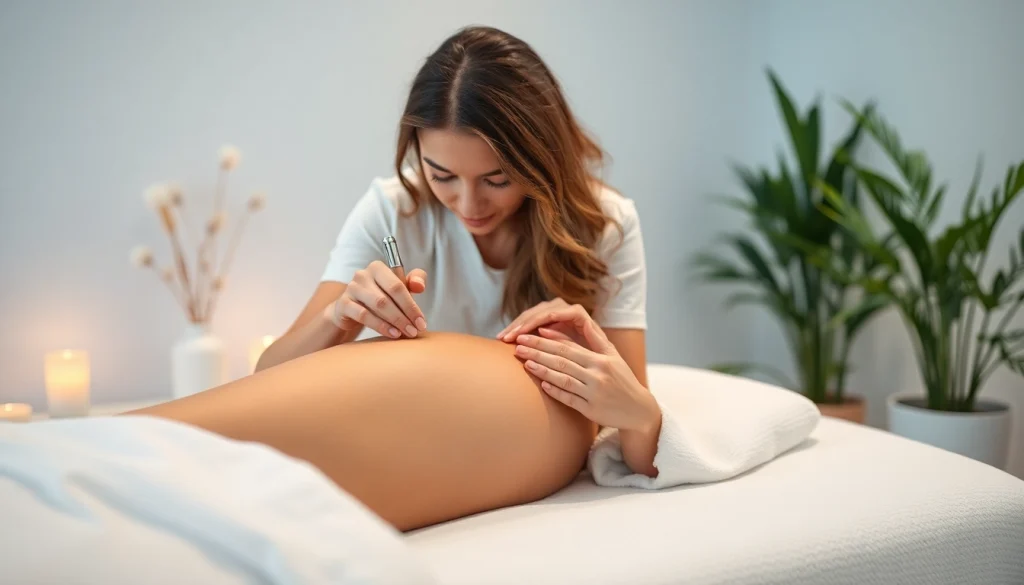
Understanding Cellulite and Its Causes
What is Cellulite?
Cellulite is a common skin condition characterized by a dimpled or lumpy appearance, primarily affecting areas such as the thighs, buttocks, and abdomen. It occurs when fat deposits push through the connective tissue beneath the skin, resulting in a noticeably uneven texture. While cellulite is not a medical concern, it can affect an individual’s self-esteem and body image, prompting many to seek various treatment options. Understanding the biology behind this condition is vital for those seeking effective cellulite therapy.
Factors Contributing to Cellulite Formation
Several factors contribute to the development of cellulite, including genetic predisposition, hormonal changes, and lifestyle choices. Genetics play a crucial role as they influence skin structure, body fat distribution, and the strength of connective tissues. Hormones, particularly estrogen, can affect the metabolic processes that lead to fat storage, fluid retention, and changes in connective tissue that promote dimpled skin. Additionally, lifestyle factors such as diet, exercise, and smoking can exacerbate the appearance of cellulite, making understanding and addressing these factors crucial for the therapeutic process.
Common Misconceptions About Cellulite
Many misconceptions surround cellulite, leading to unrealistic expectations regarding its treatment. One prevalent myth is that cellulite only affects overweight individuals. In reality, cellulite can occur in people of all body types and sizes. Another common belief is that expensive creams or lotions can completely eliminate cellulite, which is misleading. While topical treatments may improve the skin’s texture temporarily, they are often not a permanent solution. Understanding these misconceptions is essential for managing expectations regarding cellulite treatment options.
Popular Methods for Cellulite Therapy
Non-Invasive Treatments Explained
Non-invasive treatments for cellulite have gained popularity due to their relatively low risk and minimal downtime. These therapies include methods like acoustic wave therapy, radiofrequency treatment, and vacuum-assisted massage, each promoting skin elasticity and stimulating collagen production. Acoustic wave therapy utilizes sound waves to disrupt fat cell structures, while radiofrequency harnesses heat to tighten the skin and improve its appearance. Vacuum-assisted massage systems aim to enhance lymphatic drainage and stimulate circulation, which may aid in reducing the appearance of cellulite.
Advanced Procedures in Cellulite Therapy
For those seeking more intensive options, advanced procedures such as laser therapy and subcision can provide significant results. Laser treatments involve using targeted energy to break down fibrous bands that cause dimpling, leading to smoother skin. Subcision involves inserting a needle beneath the skin to sever the bands that tether fat to the skin, reducing the dimpled effect. Both of these methods typically require a trained professional and may involve some risks and recovery time. However, they often provide more noticeable and longer-lasting results compared to non-invasive techniques.
Comparing Natural Remedies and Professional Treatments
While professional treatments can offer dramatic improvements, many individuals seek natural remedies for cellulite as well. Options such as dry brushing, body scrubs, and certain dietary changes can promote circulation and improve skin appearance over time. While these methods can be beneficial, they typically require consistent application and patience to see results. In contrast, professional treatments often yield more immediate effects. Evaluating the balance between natural remedies and professional treatments allows individuals to tailor their cellulite therapy approach according to their needs and preferences.
The Science Behind Cellulite Therapy
How Treatments Affect Skin and Fat Layers
Cellulite therapies target the underlying layers of skin and fat to enhance overall appearance. Non-invasive treatments primarily focus on stimulating blood flow and lymphatic drainage, promoting collagen production, and decreasing fat cell volume. Advanced treatments often work directly on the fibrous bands that contribute to the dimpling effect. By addressing these layers, treatments can help smooth the skin’s surface and restore a more even texture.
Research Insights on Effectiveness of Treatments
Research has shown varying levels of success across different cellulite treatments. Studies indicate that acoustic wave therapy can significantly improve skin texture after several sessions, while laser therapies have demonstrated notable effectiveness in clinical trials. The effectiveness of treatments often depends on factors such as the individual’s skin type, treatment technique, and consistency of care. Evaluating evidence-based outcomes helps informed decisions regarding treatment options.
Cumulative Benefits of Consistent Therapy
Many cellulite therapies yield cumulative benefits when consistently applied. Regular sessions can lead to enhanced skin elasticity, reduced fat deposits, and improved appearance of the affected areas over time. Pairing these treatments with healthy lifestyle choices—such as a balanced diet and regular exercise—can enhance results. Adopting a holistic approach to cellulite therapy often maximizes effectiveness and promotes a more sustainable outcome.
Preparing for Your Cellulite Therapy Session
What to Expect Before Treatment
Prior to undergoing cellulite therapy, it’s important to have a consultation with a qualified practitioner. This session typically involves an assessment of the individual’s unique condition and a review of their medical history. Practitioners may discuss different treatment options and tailor a plan based on individual goals. Understanding the procedure, potential side effects, and expected recovery will help alleviate any anxiety prior to the treatment.
Setting Realistic Goals for Your Treatment
Setting realistic goals is crucial for managing expectations around cellulite therapy. While many treatments can significantly improve appearance, it’s important to acknowledge that complete removal of cellulite may not be feasible. Collaborating with a knowledgeable practitioner can help establish achievable objectives based on the individual’s unique condition and chosen methods. Clear communication about desired outcomes is essential for a positive therapeutic experience.
Aftercare Tips for Best Results
Post-treatment care plays a vital role in optimizing results from cellulite therapy. Patients are often advised to stay hydrated, avoid excessive sun exposure, and maintain a healthy lifestyle. Additionally, following any prescribed skincare routines can further enhance the skin’s texture and appearance. Those who stay committed to their aftercare regimen are likely to experience better outcomes and prolonged benefits from their chosen therapies.
Evaluating the Success of Cellulite Therapy
Tracking Progress After Treatments
Monitoring progress after cellulite treatments involves assessing visible changes in skin texture and overall satisfaction with results. Many individuals find it helpful to take before-and-after photos to visually gauge improvements. Regular follow-ups with a practitioner can provide valuable insights into ongoing treatments and adjustments to care plans, ensuring that progress remains on track.
Feedback from Patients: What Works Best
Patient feedback on cellulite therapy varies significantly depending on individual experiences and treatment choices. While some may report dramatic results from advanced procedures, others may find satisfaction with less invasive options. Gathering testimonials and reviews from individuals who have undergone specific treatments provides helpful information to those considering therapy. Understanding a spectrum of experiences helps potential patients make informed decisions about their cellulite therapy journey.
Long-term Strategies to Maintain Results
Maintaining results post-treatment involves adopting long-term strategies. Consistency in skincare routines, regular exercise, and a balanced diet play critical roles in sustaining improvements. Additionally, periodic follow-up treatments can help manage cellulite’s recurrence. Individuals who commit to an ongoing regimen can enhance the durability of their results, fostering a more positive relationship with their body image.





